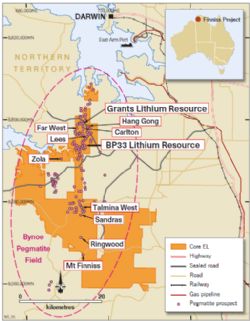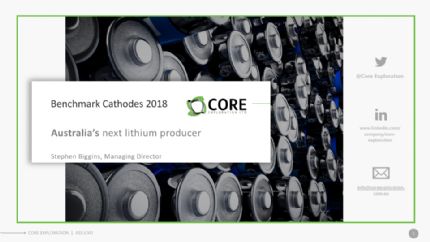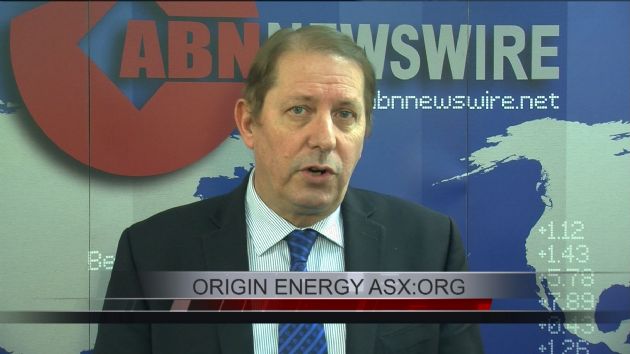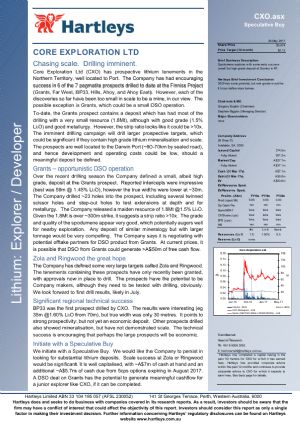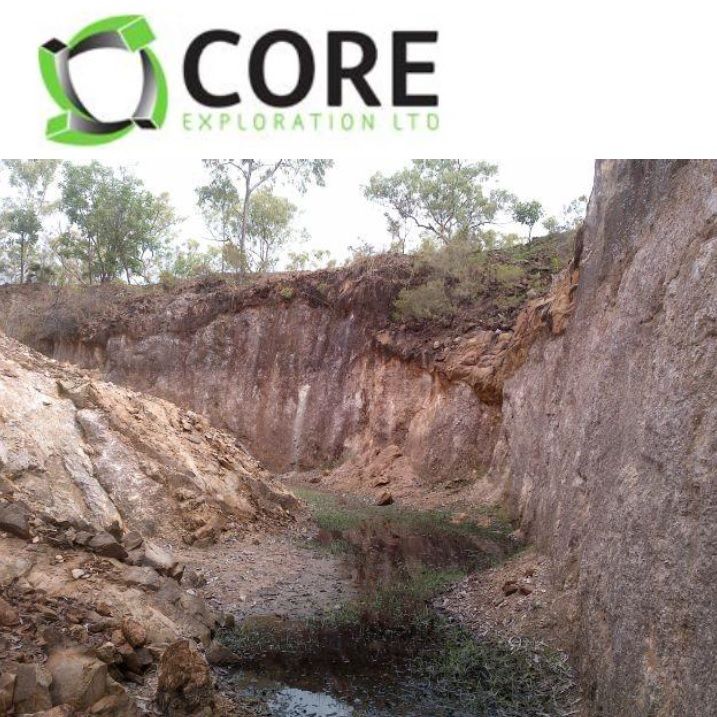
Maiden Resource Estimate at BP33
Adelaide, May 23, 2018 AEST (ABN Newswire) - Emerging Australian lithium developer, Core Exploration Ltd ( ASX:CXO) ("Core" or the "Company"), is pleased to announce a maiden Mineral Resource estimate for the BP33 Lithium Deposit, which has further increased the overall Mineral Resources of the Finniss Lithium Project in the Northern Territory to 3.45 million tonnes @ 1.4% Li2O.
ASX:CXO) ("Core" or the "Company"), is pleased to announce a maiden Mineral Resource estimate for the BP33 Lithium Deposit, which has further increased the overall Mineral Resources of the Finniss Lithium Project in the Northern Territory to 3.45 million tonnes @ 1.4% Li2O.
HIGHLIGHTS
- Maiden Lithium Resource estimate for BP33 grading at 1.4% Li2O
- Lithium Resources at Finniss expanded by 70% to 3.45Mt @ 1.4% Li2O, with addition of BP33
- BP33 Resource open directly south of 75m @ 1.68% Li2O drill intersection
- Resource extension and exploration drilling to recommence at BP33 next month aimed at increasing the size of the maiden resource
- Significant potential to grow Finniss Project Resources as BP33 and Grants are only two of many lithium rich pegmatites identified within Core's large 400km2 of tenure at Finniss
- PFS for development of Grants deposit expected next month
The Maiden Mineral Resource estimate defined by drilling to date within the BP33 Prospect, comprises an Inferred Resource of 1.4Mt at 1.40% Li2O and this grows the total Mineral Resources at Finniss to 3.45Mt @ 1.4% Li2O (see Tables 1 and 2 in link below).
The potential to expand the maiden BP33 Mineral Resource is considered high as the resource is currently extended only 20m south of the most recent drill intersection of 75m @ 1.68% Li2O (refer ASX announcement 11 April 2018) at the southern end of BP33. Resource extension and exploration drilling is recommencing next month at BP33 to test directly south of this outstanding high-grade lithium drill intersection (see Figures 1 and 2 in link below).
The BP33 Mineral Resource is open to the south and south-west in a 300m long target area between pegmatites identified at surface at BP32 Prospect and BP32W Prospect. Core's next drilling at BP33 is planned to immediately define south and south west extensions to the BP33 Resource and undertake exploration drilling in the target area between the BP33 Resource and BP32 and BP32W prospects.
The Company will also be recommencing aggressive exploration and resource expansion drilling campaigns in coming weeks over the larger Finniss Lithium Project area (see Figure 5 in link below), with the aim of substantially growing the Mineral Resource base for the Finniss Lithium Project to underpin a potential long-life lithium mining and production business.
Core's Managing Director, Stephen Biggins commented:
"We see the addition of resources at BP33 as highly valuable addition to the Finniss Project, and a first step in demonstrating strong potential for incremental growth to potential mine life that can be delivered by the highly prospective ground position over the Bynoe Pegmatite Field near Darwin in the Northern Territory.
We strongly believe that the BP33 deposit remains open to the south based on previous drilling delivering wide and high grade intersections of lithium mineralisation, and we look forward to expanding the resources at BP33 and the Finniss Project through our ongoing exploration and resource drilling."
Core is in the final stages of completing a Pre-Feasibility Study ("PFS") for the development of a spodumene concentrate and/or direct shipping ore operation from the Grants Lithium Deposit and expects to deliver the PFS next month.
Subject to positive results from the PFS, the Company then expects to complete a full Feasibility Study for the development of mining and processing lithium from the Finniss Lithium Project and is aiming to complete regulatory approvals, financing and internal approvals, and commence production at Grants at the end of 2019.
The Finniss Lithium Project has substantial infrastructure advantages supporting the Project's development - being close to grid power, gas and rail and within easy trucking distance by sealed road to Darwin Port - Australia's nearest port to Asia.
BP33 Lithium Resource
The results of the Mineral Resource Estimate for the Finniss Lithium Project including BP33 and Grants are provided in Table 1 and 2 (see link below). The Mineral Resources are reported at a high cut-off of 0.75% Li2O.
Dr Graeme McDonald (BSc PhD MAusIMM) was contracted by Core to undertake the Mineral Resource estimate for the BP33 Lithium Deposit. As part of the preparation of the Mineral Resource estimate, Dr McDonald developed a geological interpretation based on cross sections, generated a 3D geological interpretation from interpreted cross sections, created domain interpretations for lithium, developed a block model of the deposit, undertook a geostatistical analysis of the data and estimated lithium grades.
Dr McDonald's report notes that fresh pegmatite at BP33 is composed of coarse spodumene, quartz, albite, microcline and muscovite (in decreasing order of abundance). Spodumene, a lithium bearing pyroxene (LiAl(SiO3)2), is the predominant lithium bearing phase and displays a diagnostic red-pink UV fluorescence. The pegmatite is not strongly zoned, apart from a thin (1-2m) quartz-mica-albite wall facies and some barren internal quartz veins.
BP33 has a flat Grade-Tonnage curve at the 1.4% Li2O "sweetspot" for spodumene production (see Figure 3 in link below). A high 0.75% Li2O cut-off grade results in no significant reduction in the contained tonnes, demonstrating the consistent high-grade nature of the Resource.
Summary of Resource Estimate and Reporting Criteria
Geology and geological interpretation
The BP33 Lithium Deposit is hosted within a rare element pegmatite that is a member of the Bynoe Pegmatite Field. The Bynoe Pegmatite Field is situated 15km south of Darwin and extends for up to 70km in length and 15 km in width. Over 100 pegmatites are known within clustered groups or as single bodies. Individual pegmatites vary in size from a few metres wide and tens of metres long up to larger bodies tens of metres wide and hundreds of metres long.
The pegmatites are predominantly hosted within the early Proterozoic metasedimentary lithologies of the Burrell Creek Formation and are usually conformable to the regional schistosity. The Bynoe pegmatites are classified as LCT (Lithium-Caesium-Tantalum) type and are believed to have been derived from the ~ 1845 Ma S-Type Two Sisters Granite which outcrops to the west.
Fresh pegmatite at BP33 is composed of coarse spodumene, quartz, albite, microcline and muscovite (in decreasing order of abundance). Spodumene, a lithium-bearing pyroxene (LiAl(SiO3)2), is the predominant lithium-bearing phase and displays a diagnostic red-pink UV fluorescence. The pegmatite is not strongly zoned, apart from a thin (1-2m) quartz-mica-albite wall facies and some barren internal quartz veins (see Figure 4 in link below).
Drilling techniques and hole spacing
The BP33 drill hole database used for the MRE contains a total of 33 holes for 3,669.2m of drilling. Comprising 27 RC holes and 6 DD holes.
The majority of holes have been drilled at angles of between 55deg - 60deg and approximately perpendicular to the strike of the pegmatite.
The 11 RC holes drilled by Greenbushes were only used to assist with the interpretation of the geology and depth of the weathering profile, due to the fact that they are all relatively shallow and were not assayed for lithium. Geological and assay data for all other drill holes was used in the geological interpretation and MRE.
Sampling and sub-sampling
Samples were collected from RC drilling and when submitted for assay typically weighed 2-5kg over an average 1m interval. RC sampling of pegmatite for assays is done on a 1 metre basis. 1m sampling continued into the barren wall-zone of the pegmatite and then a 3m composite was collected from the immediately surrounding barren phyllite host rock. RC samples were homogenised and subsampled by cone splitting at the drill rig.
Drill core was collected directly into trays, marked up by metre marks and secured as the drilling progressed. Core was cut firstly into half longitudinally along a consistent line, ensuring no bias in the cutting plane. Again, without bias, half core was then cut into two further segments. A quarter was then collected on a metre basis where possible but not less than 0.3m in length, determined by geological and lithological contacts.
Sample analysis method
Sample Preparation - The samples have been sorted and dried. Primary preparation has been by crushing the whole sample. The samples have been split with a riffle splitter to obtain a sub-fraction which has then been pulverised to 95% passing 100 micrometre.
A 0.3 g sub-sample of the pulp is digested in a standard 4 acid mixture and analysed via ICP-MS and ICP-OES methods for the following elements: Li, Cs, Rb, Sr, Nb, Sn, Ta, U, As, K, P and Fe.
In the 2016-2017 drilling, all samples were also analysed via the fusion method - a 0.3 g sub-sample is fused with a Sodium Peroxide Fusion flux and then digested in 10% hydrochloric acid. ICP-OES is used for the following elements: Li, P and Fe. Exhaustive checks of this data suggested an excellent correlation exists, so in 2018 a 3000 ppm Li trigger was set to process that sample via a fusion method.
Selected drill core samples were also run for the following additional elements to provide a broader suite: Al, Ca, Mg, Mn, Si, LOI, SG (immersion), SG (pychnometer) and various trace elements.
Standards, blanks and duplicates have all been applied in the QAQC methodology. Sufficient accuracy and precision have been established for the type of mineralisation encountered and is appropriate for QAQC in the Resource Estimation.
Cut-off grades
The current Mineral Resource Inventory for the BP33 Deposit has been reported at a cut-off grade of 0.75% Li2O which, based on current modelling for the nearby Grants Deposit, approximates the current break even operating cost estimate for an open pit development. No top cuts were applied.
Estimation methodology
Geology and mineralisation wireframes were generated in Micromine software using drill hole data supplied by Core. Resource data was flagged with unique lithology and mineralisation domain codes as defined by the wireframes and composited to 1m lengths.
Grade continuity analysis was undertaken in Micromine software for Li2O for the mineralised domain and models were generated in all three directions. Parameters were used in the block model estimation. A block model with a parent block size of 5x10x10m with sub-blocks of 1.25 x 2.5 x 2.5m has been used to adequately represent the mineralised volume, with sub block estimated at the parent block scale.
Density data was supplied by Core and is consistent with expected values for the lithologies present and the degree of weathering. Within the block model, density has been assigned based on lithology.
Classification criteria
Resource classification has been applied to the Mineral Resource Estimate based on the drilling data spacing, grade and geological continuity, and data integrity. All of the Mineral Resource satisfies the requirements to be classified as an Inferred Mineral Resource. The classification reflects the view of the Competent Person.
Mining and Metallurgy
It has been assumed that the traditional open cut mining method of drill, blast, load and haul will be used. No other mining assumptions have been made.
No metallurgical recoveries have been applied to the Mineral Resource Estimate.
Eventual Economic Extraction
It is the view of the Competent Person that at the time of estimation there are no known issues that could materially impact on the eventual extraction of the Mineral Resource.
To view tables and figures, please visit:
http://abnnewswire.net/lnk/60CB5628
About Core Lithium Ltd
 Core Lithium Ltd (ASX:CXO) is an emerging lithium producer focused on development of its Finniss Project near Darwin in the Northern Territory. Core owns 100% of Finniss, a major developing project that lies close to existing infrastructure such as the Darwin Port, grid power, gas and rail infrastructure.
Core Lithium Ltd (ASX:CXO) is an emerging lithium producer focused on development of its Finniss Project near Darwin in the Northern Territory. Core owns 100% of Finniss, a major developing project that lies close to existing infrastructure such as the Darwin Port, grid power, gas and rail infrastructure.
The Finniss Project covers a 500km2 tenement holding and 25 historic pegmatite mines. The project area is about 80km from Darwin Port. Exploration work has generated a near term development timeline, with feasibility studies to be completed over the course of 2018 ahead of receipt of approvals in early 2019 and planned first production during 2019.
An aggressive exploration program is under way, which has confirmed the high quality prospectivity across much of the Finniss Project area. Core's stated ambition is to upgrade Finniss' resource base to fast-track commercialisation options.
| ||
|



